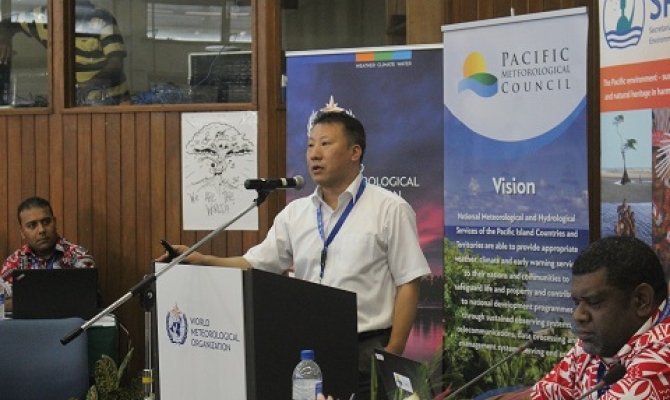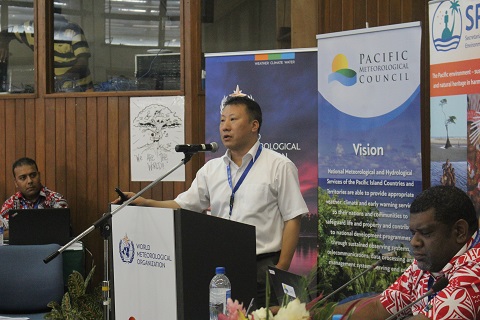
Climate Change Resilience
By Bentaake Kiima of Broadcasting and Publications Authority
16 August, 2017, Honiara, Solomon Islands, PMC-4 – Tuvalu is looking forward to using a new climate prediction model once it is release for use later in the year, says the Director of the Tuvalu Meteorological Services, Mr Taula Katea.
Mr Katea was speaking to journalists covering the Pacific Meteorological Council meeting in Honiara, where information about the new PICASO model was released.
“Hopefully, sometime at the end of the year when it’s available, we look forward to using it and we will try to compare it with the current model we are using,” said Director Katea.

Dr Jin Ho Yoo of South Korea was project leader in developing PICASO, the Pacific Island Countries Advanced Seasonal Outlook model. He is an atmospheric scientist with the APEC Climate Center.
“PICASO attempts to translate those results from the climate models in the largest scales down to localize climate for each island,” said Dr Hoo.
PICASO he added is more reliable for rainfall prediction and provides additional information to the Pacific Islands about heavy rainfall events, flooding and drought alerts. This information’s would help minimize damage in agriculture and livelihoods. - #PMC4 #PacificMet
*****
PICASO model was developed by the Republic of Korea-Pacific Islands Climate Prediction Project (ROK-PI CliPS). The project is funded by the Republic of Korea and jointly implemented by APCC and SPREP. For more information on the project visit https://www.pacificclimatechange.net/project/republic-korea-pacific-islands-climate-prediction-services-project
The Fourth Pacific Meteorological Council is being held in Honiara, Solomon Islands from the 14 – 17 August co-hosted by the government of Solomon Islands, the Secretariat of the Pacific Regional Environment Programme (SPREP) and World Meteorological Organization (WMO). This will followed by the Second Pacific Meteorological Ministers Meeting (PMMM) on the 18 of August.
The PMC and PMMM is supported by the Government of Solomon Islands, SPREP, WMO, Government of Australia through the Climate and Oceans Support Programme (COSPPac) and Pacific Australia Climate Change Science and Adaptation Planning Programme (PACCSAP), Government of Finland, National Ocean and Atmospheric Administration (NOAA), United Nations Development Programme through the Resilience in the Pacific (SIDS) project.
The PMC consists of members of the Pacific National Meteorological and Hydrological Services supported by its technical partners, regional organisations, non-government organisations and private sectors.
This article was developed by a Pacific Media Team of Reporters currently providing coverage on the Fourth Pacific Meteorological Council in Solomon Islands. This activity coordinated by SPREP is supported by a partnership between the Government of Solomon Islands, SPREP, Australia funded project (Climate and Oceans Support Program (COSPPac) and UNDP Disaster for Pacific SIDS (RESPAC) project.
The views and opinions expressed in this article are those of the writer and do not necessarily reflect the views of the Secretariat of the Pacific Regional Environment Programme (SPREP) or the United Nations Development Programme (UNDP)both of which provided funding for generating media articles.
16 August, 2017, Honiara, Solomon Islands, PMC-4 – Tuvalu is looking forward to using a new climate prediction model once it is release for use later in the year, says the Director of the Tuvalu Meteorological Services, Mr Taula Katea.
Mr Katea was speaking to journalists covering the Pacific Meteorological Council meeting in Honiara, where information about the new PICASO model was released.
“Hopefully, sometime at the end of the year when it’s available, we look forward to using it and we will try to compare it with the current model we are using,” said Director Katea.

Dr. Jin Ho Yoo, Team Leader Climate Prediction Team, APCC
Dr Jin Ho Yoo of South Korea was project leader in developing PICASO, the Pacific Island Countries Advanced Seasonal Outlook model. He is an atmospheric scientist with the APEC Climate Center.
“PICASO attempts to translate those results from the climate models in the largest scales down to localize climate for each island,” said Dr Hoo.
PICASO he added is more reliable for rainfall prediction and provides additional information to the Pacific Islands about heavy rainfall events, flooding and drought alerts. This information’s would help minimize damage in agriculture and livelihoods. - #PMC4 #PacificMet
*****
PICASO model was developed by the Republic of Korea-Pacific Islands Climate Prediction Project (ROK-PI CliPS). The project is funded by the Republic of Korea and jointly implemented by APCC and SPREP. For more information on the project visit https://www.pacificclimatechange.net/project/republic-korea-pacific-islands-climate-prediction-services-project
The Fourth Pacific Meteorological Council is being held in Honiara, Solomon Islands from the 14 – 17 August co-hosted by the government of Solomon Islands, the Secretariat of the Pacific Regional Environment Programme (SPREP) and World Meteorological Organization (WMO). This will followed by the Second Pacific Meteorological Ministers Meeting (PMMM) on the 18 of August.
The PMC and PMMM is supported by the Government of Solomon Islands, SPREP, WMO, Government of Australia through the Climate and Oceans Support Programme (COSPPac) and Pacific Australia Climate Change Science and Adaptation Planning Programme (PACCSAP), Government of Finland, National Ocean and Atmospheric Administration (NOAA), United Nations Development Programme through the Resilience in the Pacific (SIDS) project.
The PMC consists of members of the Pacific National Meteorological and Hydrological Services supported by its technical partners, regional organisations, non-government organisations and private sectors.
This article was developed by a Pacific Media Team of Reporters currently providing coverage on the Fourth Pacific Meteorological Council in Solomon Islands. This activity coordinated by SPREP is supported by a partnership between the Government of Solomon Islands, SPREP, Australia funded project (Climate and Oceans Support Program (COSPPac) and UNDP Disaster for Pacific SIDS (RESPAC) project.
The views and opinions expressed in this article are those of the writer and do not necessarily reflect the views of the Secretariat of the Pacific Regional Environment Programme (SPREP) or the United Nations Development Programme (UNDP)both of which provided funding for generating media articles.